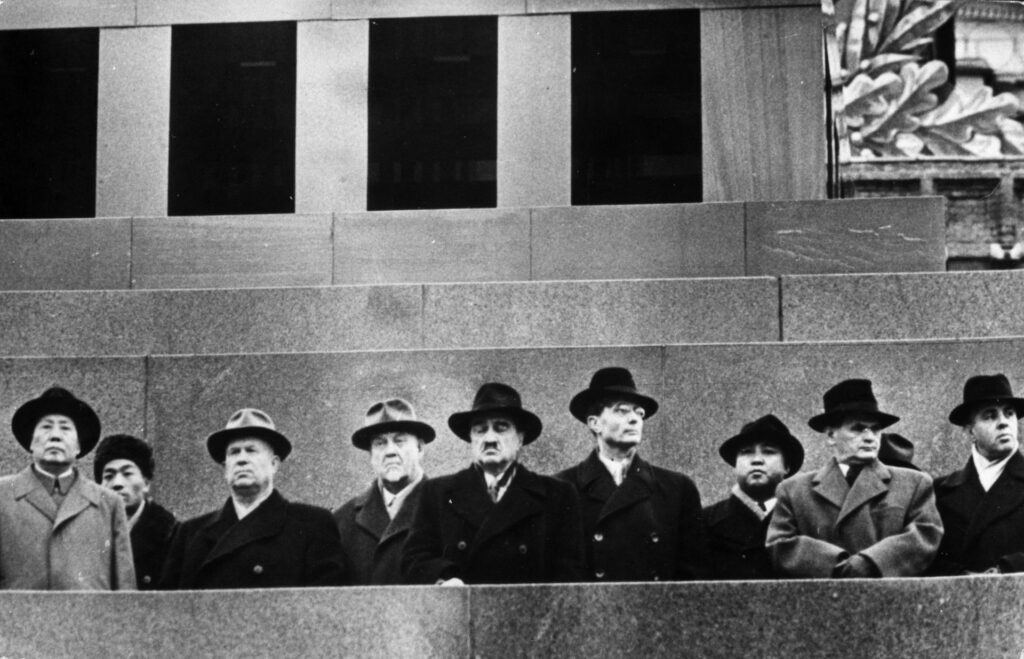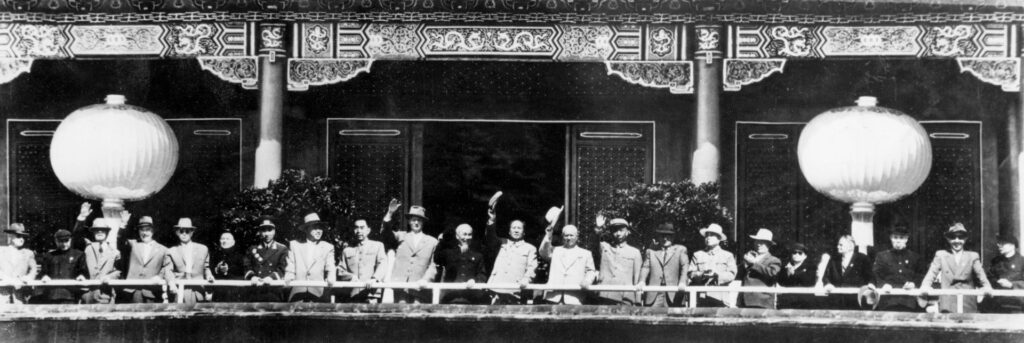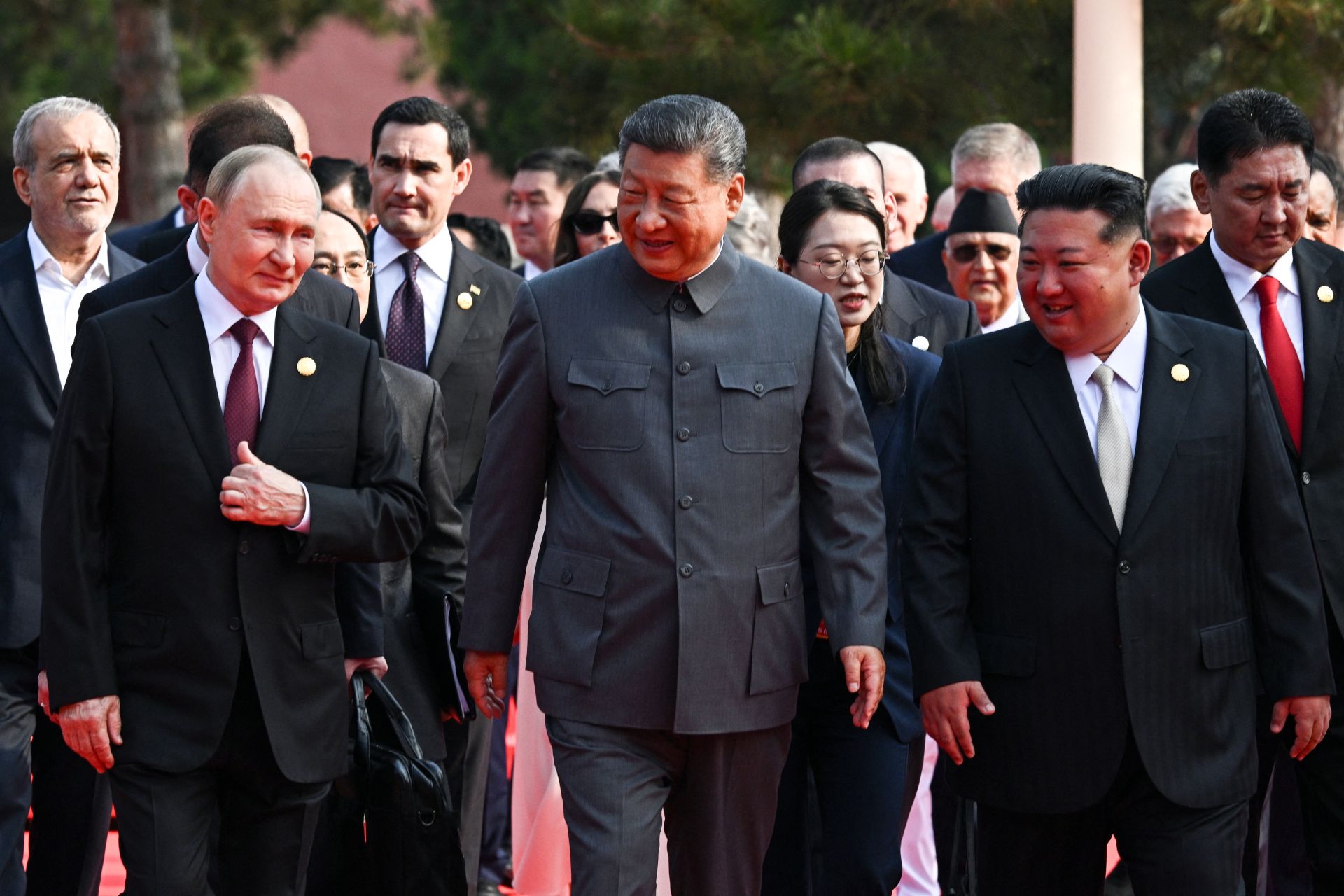The eyes of the world were on Beijing last month for a military parade marking the 80th anniversary of the end of World War II. Even more than the missiles rumbling through Tiananmen Square or fighter jets streaking overhead, the indelible image of the parade was undoubtedly the scene of Xi Jinping flanked by Vladimir Putin and Kim Jong Un, waving to adoring crowds, saluting marching soldiers and admiring new weapons.
Yet despite their ideological alignment and common enemies, the leaders of the three countries had only appeared together in public twice before. Both previous occasions were grand military displays — first in Moscow, then in Beijing — carefully choreographed shows of unity amid deeper tensions. The three countries were once united by the communist philosophy of one-party dictatorship and economies managed entirely by the state. Together, they conspired to launch the Korean War in 1950, the first and bloodiest showdown of the Cold War. Geographically, their borders converged in a tense corner of the world, staring down a nuclear-armed superpower — the United States — and its regional allies: Japan, South Korea and Taiwan.
Mao Zedong and Kim Il Sung, the grandfather of Kim Jong Un, traveled to Moscow in 1957 to celebrate the 40th anniversary of the October Revolution. “Our skies are all bright but those of the West are darkened by clouds,” Mao said in a speech. “We are very optimistic, but how about them? They are in a state of anxiety.”
Assembled on the tribune atop the mausoleum that then housed both Vladimir Lenin and Josef Stalin, they watched the military parade through Red Square. Mao was accorded the spot of honor to the right of First Secretary Nikita Khrushchev.
A closer look at the historical context behind these rare displays of unity reveals a far more complex story about the dynamics between these regimes and their leaders.
Mao relied on Soviet support in founding the People’s Republic of China in 1949, but he had come to consider himself the alpha of the communist bloc after Stalin’s death, and held Moscow in contempt. “They’re trying to eat us up,” Mao said of the Soviets to his doctor and confidant Li Zhisui. For his part, Khrushchev recalled of Mao that he “played politics with Asiatic cunning, following his own rules of cajolery, treachery, savage vengeance, and deceit.”
Kim had also founded a country, the Democratic People’s Republic of Korea, in 1948, with Soviet support. He could not realistically expect to stand front and center next to Khrushchev and Mao — he was a generation younger and led a small nation still rebuilding after the devastation of the war. Still, Kim was placed not too far away, one row behind the rest, his boyish face peering over the shoulder of the interim president of Czechoslovakia, Viliam Široký.
The world’s dozen ruling communist parties all had delegations at the Moscow parade, as did representatives of over 50 communist parties vying for power across the globe. The only notable exception was the family’s black sheep, Yugoslavia, which charted its own course under Josip Broz Tito after World War II, splitting with Moscow’s foreign policy.
At the time, The New York Times reported that Mao was the “center of attention” from the moment he arrived in Moscow. “Everyone seemed to want to meet him or, if they knew him, to exchange a few words.” The CIA saw the gathering as the manifestation of a Sino-Soviet bid to “achieve a shift in the balance of power” globally, as explained in a brief from December. The image of the Russian and Chinese leaders flanked by heads of state from both ends of Eurasia captured the West’s deepest fears of an axis of communist autocracy and upheaval.
But the outward display of comradeship in Moscow that November masked deep anxiety and insecurity that had been simmering among communist leaders since February of the previous year. That was when Khrushchev’s jaw-dropping “secret speech” denouncing Stalin’s brutal reign sent shockwaves through the communist world, unleashing a tide of unrest across the Soviet bloc. The speech, delivered in closed-door meetings but circulated to top cadres worldwide, was the start of a major de-Stalinization campaign that aimed to break the image of the dictator as a perfect leader and return government policy to an idealized version of Vladimir Lenin’s ideas.
In Poland, protests erupted. In Hungary, a full-scale uprising broke out — only to be crushed when Soviet tanks thundered into Budapest, killing thousands of civilians. On home soil, the speech cemented the “thaw,” as repression and censorship were relaxed by Khrushchev.
Even in China, cracks began to show. After Mao encouraged intellectuals to speak freely — inviting them to “let a hundred schools of thought contend and a hundred flowers bloom” — he was shaken by the flood of criticism that followed. By the summer of 1957, the experiment in openness was over. Mao reversed course with a vengeance, launching the Anti-Rightist Campaign — a sweeping purge that punished those who had dared to respond to his call for honesty. Anyone with an education or in a position of authority was vulnerable to being labeled a rightist, which led to people being demoted, fired, arrested, incarcerated, beaten to death or forced to commit suicide. The party’s official tally of victims of the campaign was half a million people.
North Korea, outwardly, remained silent. Intellectuals stayed obedient, and the public knew better than to protest. But beneath the surface, tensions were brewing. While Kim was abroad on a six-week tour of the Soviet Union and Eastern Europe in the summer of 1956, dissent within the Korean Workers’ Party briefly flared. Rivals plotted to unseat him. But upon his return, Kim swiftly crushed the plot. His challengers fled into exile in China, and he reasserted his grip on power with ruthless efficiency.
Worried that Kim would overreact in eliminating any hint of opposition, in September 1956 Mao and Khrushchev sent envoys to Pyongyang in a joint intervention, ordering Kim to stand down. The interference made Kim’s blood boil, but he needed to be seen to acquiesce. At that point, China maintained a massive military presence in North Korea — hundreds of thousands of troops left behind from the 3 million Chinese People’s Volunteers who had poured across the Yalu River during the Korean War. In 1950, Chinese forces had saved Kim’s regime from collapse, driving back American troops and restoring the front line near the 38th parallel. But the Chinese troops that remained after the signing of the Korean Armistice Agreement in July 1953 were a double-edged sword for Kim. On one hand, they served as a powerful deterrent against the U.S.-backed South. On the other, their presence gave Mao a degree of influence over North Korea’s internal affairs — an uncomfortable reminder to Kim that his regime’s survival had come at a cost.
With all this turmoil churning under the surface of the happy scene at the Moscow Parade, Kim seized the opportunity of side talks with Mao, who apologized to Kim for the previous year’s joint intervention and offered to bring Chinese soldiers home. The two leaders agreed on a timeline for the withdrawal, hoping to pressure the Americans to reciprocate by leaving South Korea. Sure enough, one year later all Chinese troops would be gone from the North, never to return. Coincidentally, around the same time the U.S. slashed the number of soldiers stationed in South Korea but would retain a minimum level of 40,000 men throughout the Cold War (28,500 American soldiers are still stationed on the peninsula today).
Just months before hosting the parade, Khrushchev, too, had to scramble support to avoid being removed from power by what he labeled the “anti-party clique.” Yet Moscow continued to instruct fraternal parties to reject the cult of personality and replace Stalinist dictatorship with “collective leadership.” Mao and Kim, charismatic and autocratic leaders who aspired to god-like status, were never happy with the implications of Khrushchev’s so-called secret speech. Having fought off the challenge to his rule but submitted to intervention the previous year, Kim dared to ignore Soviet advice in the lead-up to the parade. When there were no consequences to his intransigence, Kim moved to consolidate absolute power, building a political cult like no other in scale or duration. “From the autumn of 1957, the USSR started to lose control over North Korea,” Fyodor Tertitskiy writes in his brilliant new biography, “Accidental Tyrant: The Life of Kim Il Sung.” Kim was able to watch the parade in Red Square, even one row back, with a certain degree of self-satisfaction at his capacity to manage his two neighboring great powers.
Mao refused to heed Khrushchev’s advice in even more assertive ways than Kim. By the second parade that brought the three leaders together two years later, in 1959, self-confidence was leading Mao to declare Beijing the new center of world revolution.

The 1957 visit to Moscow was the second and final time Mao would step foot on foreign soil. After that, Khrushchev needed to come to him. When the Soviet leader secretly visited Beijing the next summer, Mao humiliated him by holding talks in a swimming pool, leaving Khrushchev with no choice but to strip to his satin undershorts and flounder in the water next to the Chinese leader, a much better swimmer.
Khrushchev nonetheless returned to Beijing for a very public visit the following year to attend the October Military Parade marking the 10th anniversary of the founding of the People’s Republic of China.
Photos from that 1959 meeting feel like a petrified image of the Cold War bloc at peak solidity, just before fracturing into acrimony and polemics. The Soviets, having survived the turmoil of the Polish and Hungarian revolts, were riding high on the perceived advantages that Americans referred to as the “Sputnik Moment” and “missile gap.” Moscow was clearly winning the space race, having launched the world’s first satellite, and seemed to be ahead in the production of missiles that could strike Western Europe and intercontinental ballistic missiles that could hit the U.S.
Khrushchev flew to Beijing soon after returning from a two-week state visit to the United States at the invitation of President Dwight Eisenhower, the first time a Soviet leader walked on American soil. It was a strange sort of charm offensive, intended to reduce the risk of World War III but also to impress and intimidate the other side. In Los Angeles, he warned that the Soviet Union was rolling out missiles “like sausages.” In Iowa, he was photographed smiling as he ate a local hot dog.
If Khrushchev’s time in America was a publicity coup for communism, the socialist bloc was also feeling enthused by picking up a new friend in the Western Hemisphere with Fidel Castro’s revolution in Cuba — a chance, perhaps, to give the Americans a taste of their own medicine one day. In Asia, there was reason to hope that North Vietnam would prevail in its People’s War against the unpopular, U.S.-backed regime in Saigon. Mao had prophesied in a speech given to comrades in Moscow that “the east wind is prevailing over the west wind.” Two years later in Beijing, his prophecy could be seen to be bearing out.
As the marching began on the morning of Oct. 1, on the Tiananmen platform Mao was flanked by Khrushchev on his left and Vietnamese leader Ho Chi Minh on his right. Kim did make it to the front row of the balustrade this time, standing between Premier Zhou Enlai and Marshal Lin Biao, in a Western suit that sartorially put him in company with the Russians rather than the Chinese and Vietnamese. It was a group portrait of communist world revolution at high tide. But it was on this visit that Khrushchev’s patience with Mao finally ran out. As vividly described by historian Sergey Radchenko in his magisterial “To Run the World,” the private discussions between Mao and Khrushchev on the sidelines of the parade were disastrous, “not far from ending in a brawl.”

The socialist bloc honeymoon of the 1950s ended sharply during the summer after the parade. Radchenko quotes a scathing line from Khrushchev, who told fellow comrades that when he looked at Mao, he saw Stalin — only less intelligent. Khrushchev acted on his contempt by pulling over a thousand Soviet experts out of China, an act of separation that marked the official start of the Sino-Soviet split. That schism would hobble cooperation for the remainder of the Cold War and leave permanent scar tissue.
The Soviets and Chinese tried to turn Kim against the other, but to no avail. Wily and more worldly than they gave him credit for, Kim traveled to Moscow and Beijing in the summer of 1961, signing separate bilateral defense treaties with the two rival powers. He would maneuver back and forth between the two countries, exploiting their distrust as best he could to North Korea’s advantage. The split was not sutured until Mikhail Gorbachev’s reconciliation visit to Beijing in May 1989, a diplomatic breakthrough completely overshadowed in optics by the Tiananmen democracy protests that were ongoing throughout his visit. Sino-Soviet rapprochement was then dwarfed in geopolitical significance by the fall of the Berlin Wall and the collapse of the Soviet Union itself two years later. In the initial phase of the dizzying post-Cold War, U.S.-dominated new world order, China, Russia and North Korea each went their separate ways.
The 1959 Beijing parade was the last meeting of northeast Asia’s triumvirate — until 2025. The celebration of solidarity led by Xi, Putin and Kim Jong Un, to a degree not witnessed in public for seven decades, should make the world take notice. But history also cautions against leaping to facile conclusions about a new anti-Western bloc or axis of upheaval bent on achieving a “shift in the balance of power.”
Even at its zenith in the late 1950s, the triangle formed by Beijing, Moscow and Pyongyang proved unstable. History serves as a reminder of how geopolitical forces, and interpersonal dynamics among leaders, tend to be far more complicated than the diplomatic veneer. Knowing the past does not predict the future — on the contrary, it alerts us to the limits of our knowledge about the complexity unfolding before our eyes. Western observers had only the foggiest notion of the internal political challenges facing Khrushchev, Mao and Kim, and the tensions between them were but dimly comprehended.
Today, as we watch new forms of bloc politics on parade, history reminds us to be modest about the conclusions we draw in the moment and to stay alert to the contradictions lurking beneath the surface logic of events.
Become a member today to receive access to all our paywalled essays and the best of New Lines delivered to your inbox through our newsletters.



